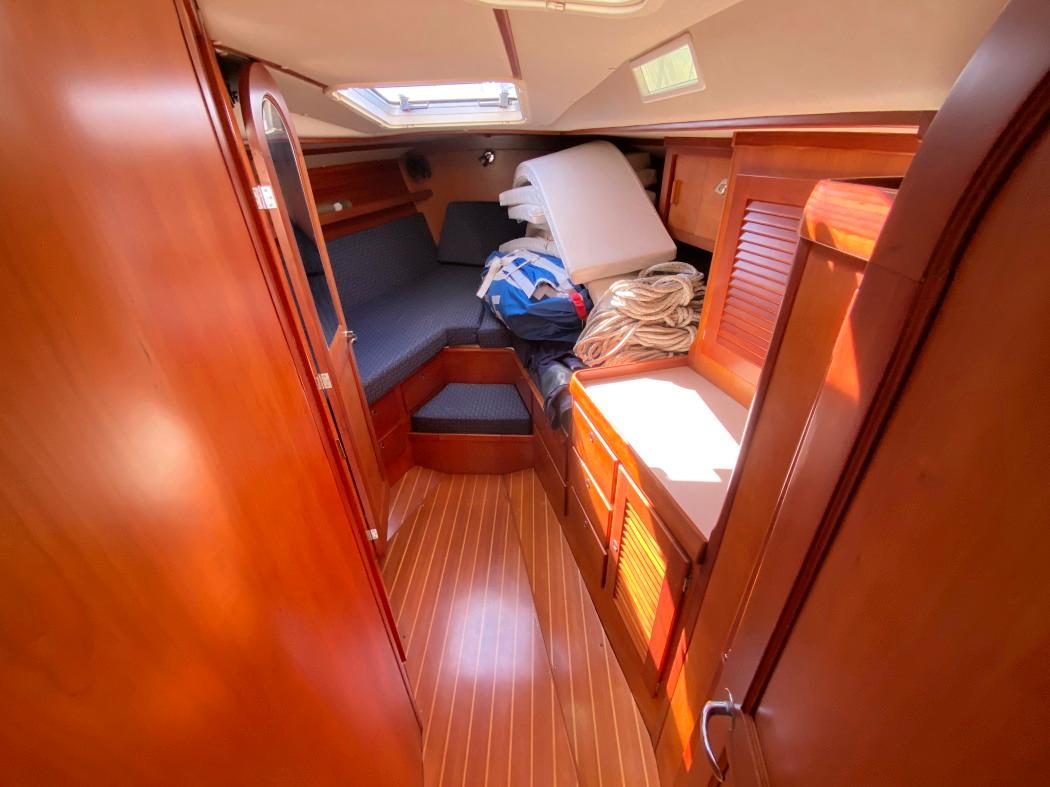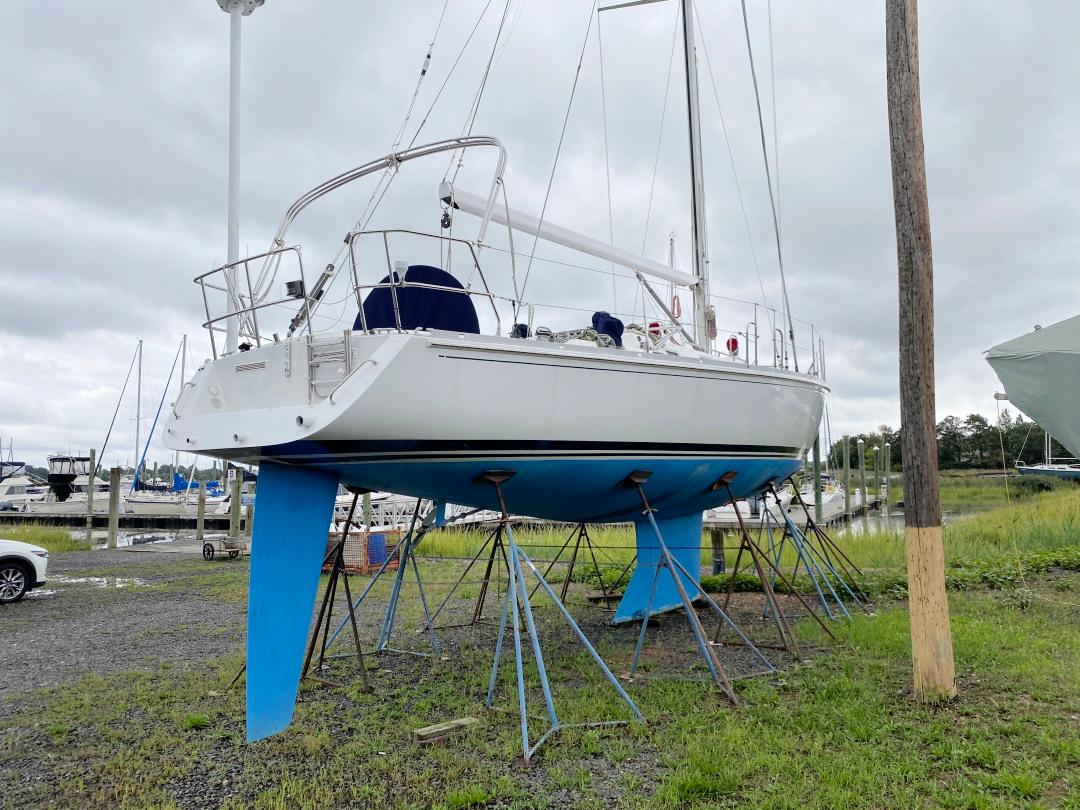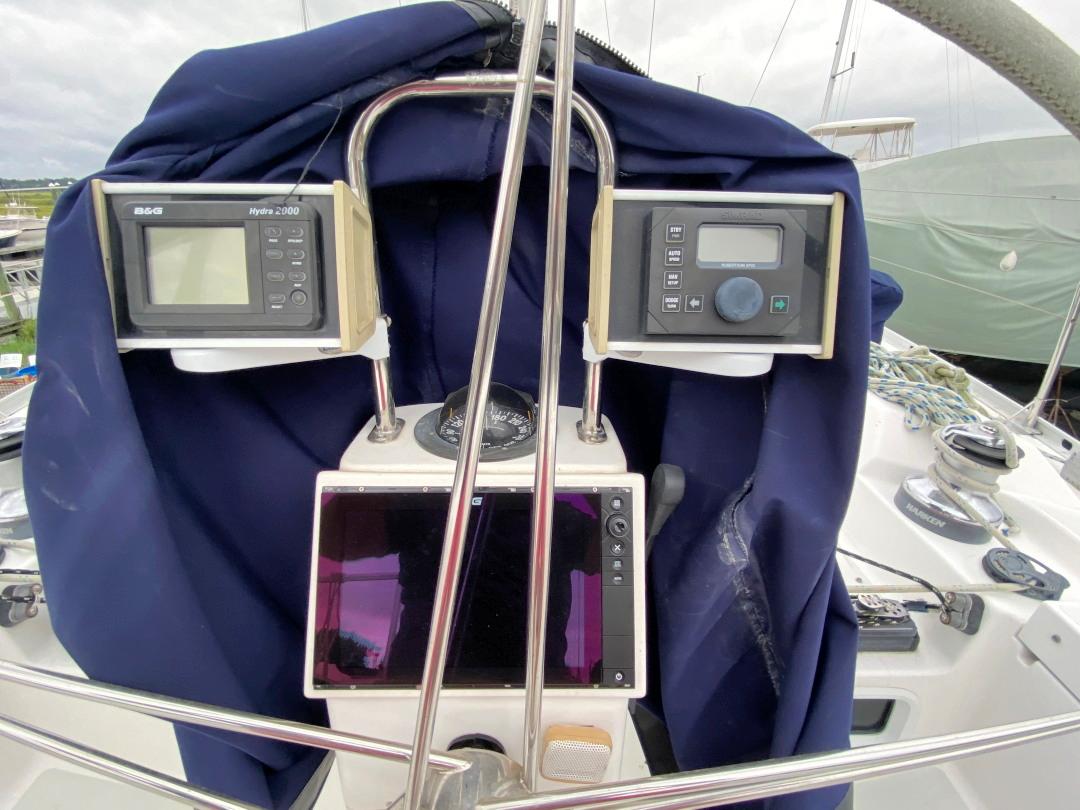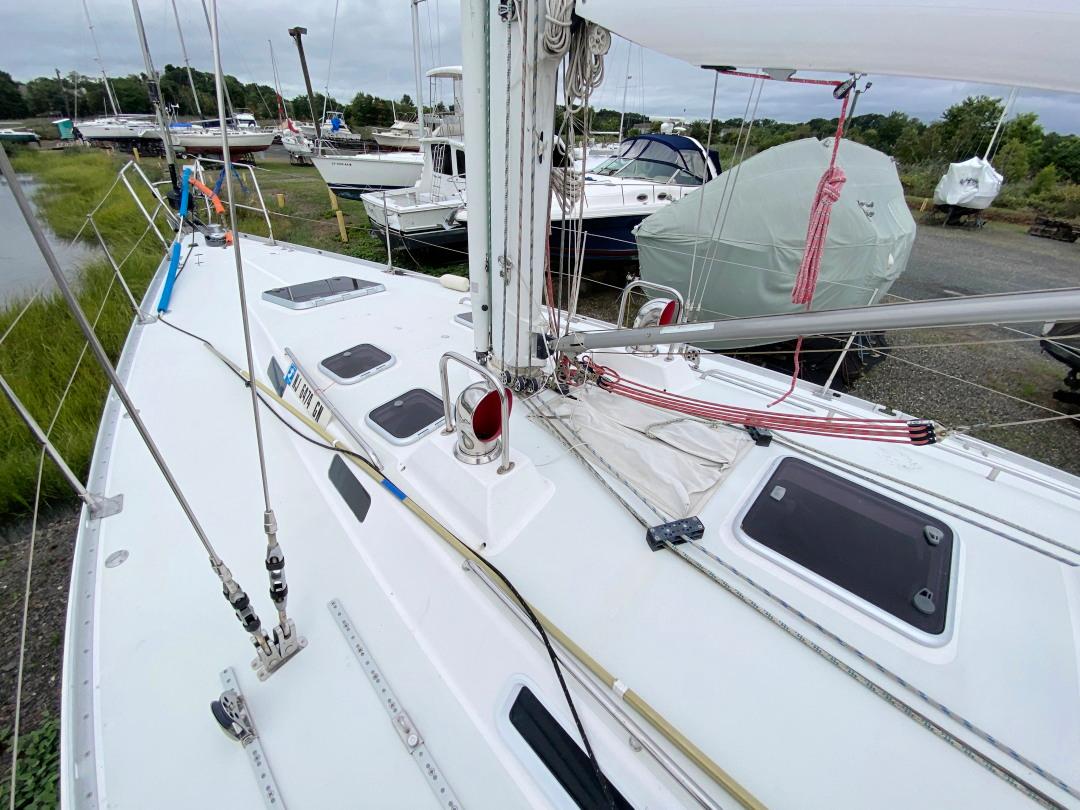Yachts For Sale
Any brand of yacht for sale. You can also use the search fields to find yachts by brand, state, length, year and price.
Yacht Overview
- Yacht Details J Boats
- Year 2000
- Location South Amboy, NJ, US
- Engines 1
- Last UpdatedNov 13, 2024
- Asking Price$299,900.00
Have a question about this yacht?
You step down from the cockpit into a spacious main cabin, with a U-shaped galley to port and a navigation station to starboard. A guest stateroom is aft of the Nav station and features a double berth, a set of drawers and a hanging locker. This would make a valuable seagoing berth under way. A head with shower is tucked behind the galley to port, with easy access to the Yanmar diesel from both the aft cabin and head as well as the companionway steps.
The saloon is airy, with three opening ports and lots of hatch ventilation, finished in cherry wood joinery. A U-shaped dinette with table is immediately forward of the galley, and with the conventional berth/settee opposite, you can sit at least six people down to dinner in comfort.
The galley is complete with a Force 10 three-burner stove with an oven, a large refrigerator and deep, double sinks and abundant storage.
The navigation station opposite has a comfortable, forward-facing seat, with a large chart table with a hinged top. There is plenty of room for electronic devices of all kinds, with the electrical panel behind your head.
From the saloon you pass into the spacious forward cabin, with a larger head and separate shower compartment to port. Locker space lies to starboard of the head. Both heads have white plastic surfaces that are easily cleaned. The forward cabin itself is a huge V-berth with central insert and shelves and lockers outboard, a large hatch overhead for air.
Salon
- U-shaped dinette with table to Port
- Berth/Settee to Starboard
- Forward Facing Nav Station
- Cherry Interior
- Overhead Grab Rails
- Outboard Shelves and Cabinets
- Teak and Holly Sole
Galley
- Force 10 3 Burner Gimballed Stove with Oven
- Sharp Microwave Oven
- Double Stainless Steel Sink
- Sea Frost Refrigeration
- Storage
Forward Stateroom
- Large Comfortable Berth
- Hanging Locker
- Overhead Hatches
- Ports
- Countertop
- Drawers/Storage
- Ensuite Head with Separate Stall Shower with Seat, Electric Toilet and Molded Vanity
Aft Stateroom
- Double Berth
- Drawers
- Countertop
- Hanging Locker
- Fan
- Operable Ports
Aft Head
- Toilet
- Sink
- Hanging Locker
- Hand Held Shower
- Access Door to Lazerette
On deck, the layout is simple and efficient. A large, T-shaped cockpit with a comfortable bench seat aft that contains a lazarette and propane locker below. The 60-inch wheel is partially recessed into the cockpit floor and just the right size for sitting to windward or leeward. The main traveler and its controls are immediately forward of the helm, with two Harken 48s controlling the double-ended mainsheet. Two long, contoured seats allow for sunbathing and are extremely comfortable when heeled, with Harken 64 primary winches close at hand. All halyards and sail controls are led aft to the cockpit, with two convenient Harken 53 self-tailers and an army of stoppers close to the companionway.
The deck is uncluttered, with good nonskid, well-placed stainless steel cabinhouse grabrails and a locker recessed into the deck forward. A convenient anodized toerail with well-placed fairleads surrounds the boat.
- 60″ Wheel
- Optional up-sized Harken Winches (64 2X; 53 2X; 48 2X).
- Optional Double Lifelines for Safer Cruising
- Optional Chrome Dorades
- Cockpit Cushions
- Lewmar Windlass
- Optional Double Anchor Roller
- Bimini/Dodger
- Optional Rub Rail
- Stern Platform
- Boarding Ladder
- Cabin-Top Grab Rails
- Winter Cover
- Helm Cove
- Winch Covers
Nav Station
- B&G Multi Function Display
- B&G Hydra 2000 Display
- Icom IC710 MF/HF Marine Transceiver
- Simrad RT 1200 VHF
- Alpine Stereo
Companionway
- B&G Hydra 2000 (2X)
- B&G Hydra 20/20
Helm
- B&G Multi Function Display
- B&G Hydro 2000
- Simrad Robertson AP22 Autopilot
- Richie Steering Compass
- B&G Radar
- Mainsail
- Genoa
- Asymmetrical Spinnaker
- Tri-Sail
- Carbon Fiber Mast
- Carbon Fiber Pole
- Rod Rigging
Propulsion
- Yanmar Diesel Engine 75hp (521 Hours)
- Max Prop
Electrical
- Fisher Panda Generator (Low Hours)
- Shore Power
- Shore Power Cord
- Electric Panel at Nav Station
- 110V Courtesy Outlets
- Inverter
- Batteries (2 Years Old)
HVAC
- Marine Air HVAC
Plumbing
- Propane Locker
- Sea Frost Refrigeration
The J-46, with the help of state-of-the-art materials and building techniques, has evolved over ten years from the combined experience and knowledge of J Boats, TPI, and nearly 100 J-44 owners. The J-44 to date has been the most successful offshore 45 foot (44.9 ft) cruiser – racer in the world. Honored in 1990 by Sailing World Magazine as Overall Boat of the Year, the yacht’s reputation has continued to grow. Winner of the Fastnet, Sydney-Hobart, two TransAtlantic races, and the New York Yacht Club’s Queen’s Cup, the J-44 is the only class of yacht to ever be granted its own start by the Cruising Club of America in the Newport- Bermuda Race. The seaworthiness of the design is unquestionable. The sleek, low resistance shape of the hull was not designed to conform to any rating rule. This boat was created to the only rule that counts: the Rule of the Sea, which is timeless. The J-46 brings performance cruising to an exciting level. Using the seakindly hull shape of her J-44 predecessor, the J-46 benefits from recent advancements in construction technique, keel and rudder design, interior styling, and simplified sail handling systems to create an ideal offshore yacht. Two people can easily manage her upwind and down to achieve the same 8 knot passagemaking speeds under sail that is possible when motoring with a 76 hp diesel auxiliary. Many cruising yachts compromise sailing comfort and performance in favor of “dockside comfort.” What seems good at a boatshow may not be desirable when heeled at 15-20 degrees at sea. This fundamental difference in design philosophy sets the J-46 apart from other boats. The J-46 is designed from the outside in. The priority is sailing quality: how well the boat balances, how well she sails through waves with minimal commotion, and how well she treats her most valuable cargo – her crew. The same qualities that make J-46 a dream to sail also contribute to her seaworthiness, manageability, and performance. The J-46 is evidence that a high performance sailboat with predictable handling can also be comfortable belowdecks. The elegantly appointed interior, finished in satin varnished cherry, is befitting her status as an investment-grade yacht. The layout features two staterooms, two heads, and a large navigation station and galley, striking an excellent compromise between practical “working” space and comfortable living quarters. Unlike rule-inspired hull shapes, the J-46 features a high length-to-beam ratio combined with ample reserve buoyancy forward. High length-to-beam ratio ensures straight tracking in rough seas with minimal steering loads on autopilot or helmsman. Greater balance of reserve buoyancy in the ends of the hull also improves handling in following seas, helping to lift the bow over the wave ahead instead of submerging. Sailboats with fine ends and full midship sections are more difficult to balance and more likely to hobby-horse and spin out of control in offshore conditions. The J-46 balances so well she can sail with either main-only or jib-only sail configurations. The challenge in cruising design is to have enough sailpower and a low enough center of gravity for the boat to perform well. This is even more of a challenge with shoal draft cruising yachts. No boat will perform if the inertia of the combined weight of gear and hull weight being tossed about in waves overwhelms the stabilizing effect of sail area. The J-46 achieves added stability with a carbon fiber mast (which is half the weight of aluminum), the SCRIMP deck and hull (which are lighter and stronger than other production cruisers), and her modem keel design with lead bulb. The combination of these features results in unusual stability for a boat of this length and draft. TPI Composites has become the world leader with its patented SCRIMP molding system. Using similar materials, this process yields a J-46 hull & deck laminate tested at double the strength of the hand lay-up construction found in most other modern boats. The difference in strength is fiber content. A SCRIMP laminate has almost twice the fiber and half the resin. The process is so good, TPI has licensed the technology to leading aircraft and transportation companies for use in airframe and composite vehicle construction. The J-46 is designed to fly a modern asymmetric spinnaker with two people. An 18″ clearance between the headstay and the spinnaker halyard allows the spinnaker snuffer to roll around the face of the mast without getting fouled. The forward corner of the spinnaker is fixed to the anchor roller. The snuffer up – down lines are led aft, so that “snuffing” is simply a matter of casting off the spinnaker sheet and pulling the “down” line – all safely done without leaving the cockpit. Imagine being able to cruise with 100 per cent jib instead of an unwieldy genoa. Or, simply roll up the jib in over 20 knots of wind and sail with mainsail alone up to 30 knots without needing to reef. The mainsail flattens out with several strokes of the hydraulic backstay. The J-46 is easily sailed by one person with minimal fuss. How well does this boat sail Five of her less sophisticated J-44 predecessors sailed upwind to Bermuda in the rough 1990 race faster than all Swans between 48 and 61 feet in length. There is no other offshore cruising yacht of its size to compare with the all-around qualities of the J-46, considering the important attributes of seaworthiness, strength of construction, performance, ease of handling, and liveaboard comfort.
Get More Info on
Share With a Friend
Price Watch:
Have any inquiries about the above boats?
We can help.
Contact bluenose yachts today for special sailboat pricing!
Boat Inquiry
Contact us to learn more about our offered sail & power boats.





















































